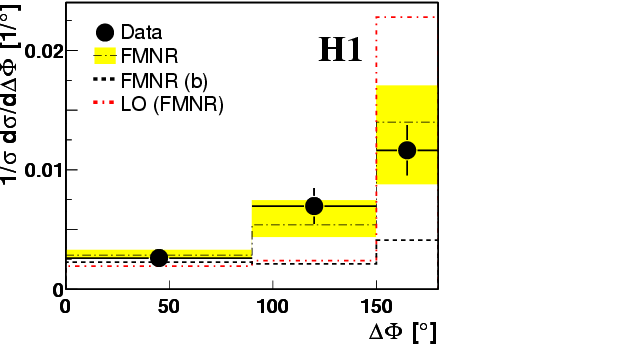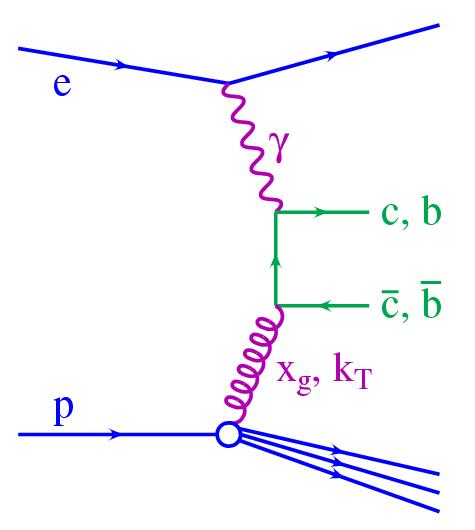
Measurement of Charm and Beauty Photoproduction at HERAusing D* mu Correlations |
 Measuring heavy quark production in ep collisions at HERA
is an ideal testing ground for studying the strong force.
At HERA heavy quarks are predominantly produced via
photon-gluon fusion, which is illustrated in the diagram on the
right hand side.
This process is directly driven by the gluon density g(xg)
in the proton, where xg is the relative momentum
fraction of the gluon with respect to the total proton momentum.
The large mass of the heavy quark provides a hard kinematical scale,
which allows the calculation of cross sections
by means of perturbative-Quantum-Chromo-Dynamics (pQCD).
The heavy quark production cross section is largest for
photoproduction, i.e. for photons with virtuality
Q2 approximately 0.
The light quarks u,d and s are produced much more copiously
than c and b, and beauty production is suppressed by a
factor of approximately 200 compared to charm.
Charm and beauty measurements performed at HERA so far relied
on the tagging of only one heavy quark in each event.
While the charm measurements were mostly based on the
reconstruction of D mesons, the beauty measurements used
semi-leptonic decays or lifetime signatures or both.
In this analysis both heavy quarks are tagged in a large
fraction of events using a D* and a muon as signatures.
Measuring heavy quark production in ep collisions at HERA
is an ideal testing ground for studying the strong force.
At HERA heavy quarks are predominantly produced via
photon-gluon fusion, which is illustrated in the diagram on the
right hand side.
This process is directly driven by the gluon density g(xg)
in the proton, where xg is the relative momentum
fraction of the gluon with respect to the total proton momentum.
The large mass of the heavy quark provides a hard kinematical scale,
which allows the calculation of cross sections
by means of perturbative-Quantum-Chromo-Dynamics (pQCD).
The heavy quark production cross section is largest for
photoproduction, i.e. for photons with virtuality
Q2 approximately 0.
The light quarks u,d and s are produced much more copiously
than c and b, and beauty production is suppressed by a
factor of approximately 200 compared to charm.
Charm and beauty measurements performed at HERA so far relied
on the tagging of only one heavy quark in each event.
While the charm measurements were mostly based on the
reconstruction of D mesons, the beauty measurements used
semi-leptonic decays or lifetime signatures or both.
In this analysis both heavy quarks are tagged in a large
fraction of events using a D* and a muon as signatures.
In order to separate charm and beauty contributions the charge and azimuthal angle correlations of the D* meson and muon are exploited. The measurement of the b cross section presented here extends to significantly lower centre-of-mass energies of the b-pair system than previous measurements at HERA which require high momentum jets. The simultaneous detection of the D* meson and the muon makes possible new tests of higher order QCD effects. For instance, in the photon-gluon rest frame the angle between the heavy quarks is 180o at leading order, but at next-to-leading order it can differ significantly from this value due to hard gluon radiation. Furthermore, the D*muon pair is expected to be sensitive to a possible transverse momentum kT of the gluons entering the quark pair production process.
Results
The total measured cross section for charm in the visible kinematic
region is in agreement with the NLO QCD prediction, while the beauty
cross section is higher than predicted.
Differential cross sections for D*muon production are evaluated as a function of variables characterising the D* meson, the muon and the D*muon system. For these distributions the complete data set, which contains the contributions from charm and beauty, are used. The figure shows exemplarily the D*muon cross section as a function of the azimuthal angle difference between the D* meson and the muon. The QCD calculations including higher order effects (indicated in the left plot with FMNR) show general agreement with the shape of the data. Effects beyond the LO approximation are directly observed.

What did we learn
The total measured cross section for charm in the visible kinematic
region is in agreement with the NLO QCD prediction, while the beauty
cross section is higher than predicted. The kinematic region of the
latter is characterised by lower b anti-b centre-of-mass energies than
in the most previous analyses, which require high momentum jets.
Comparisons of the shapes of the measured differential distributions
with the QCD calculations including higher order effects show general
agreement. Effects beyond the LO approximation are directly observed.